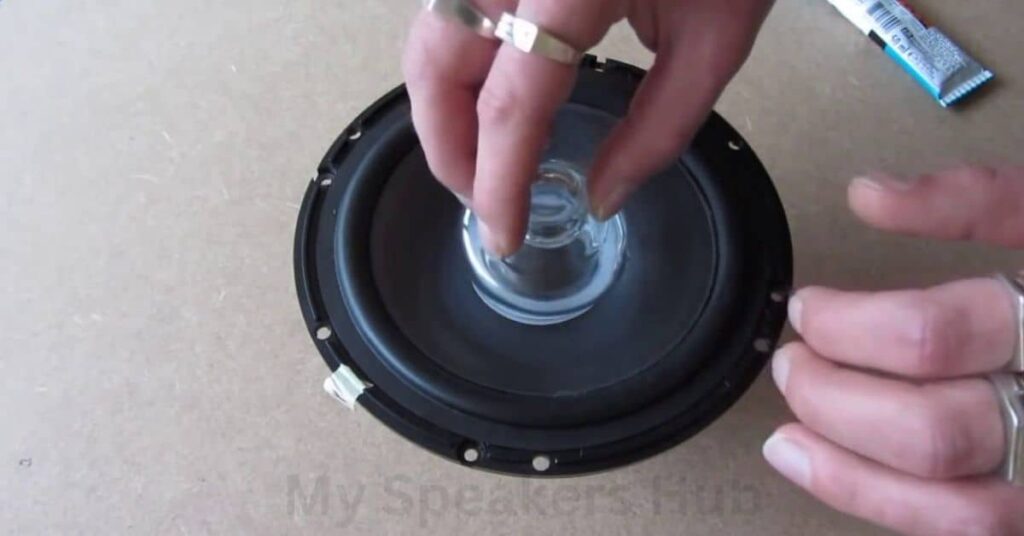Do you have a ripped subwoofer cone? Then you are in luck! In this article, we will discuss how to fix a ripped subwoofer cone so that you can get your sound system up and running again. We will provide step-by-step instructions and tips on how to make sure the job is done correctly. So, read on and get ready to repair your subwoofer cone!
Materials You Need to Fix a Ripped Subwoofer Cone
In order to fix a ripped subwoofer cone, you will need a few materials, including a replacement cone, adhesive, a utility knife, sandpaper, and a screwdriver. To begin, remove the subwoofer from the enclosure and unscrew the screws to take off the speaker cover.
Gently pull out the old cone and discard it, and then measure the diameter of the replacement cone to ensure it is the correct size. Apply the adhesive to the frame and carefully place the new cone into position. Once secured, use the utility knife to trim off any excess material. Finally, use the sandpaper to smoothen any rough edges before reattaching the speaker cover and screws.
Step-by-Step Guide to Repairing a Subwoofer Cone
Step 1: Determine the Problem: Before attempting to repair a subwoofer cone, you should identify the cause of the problem. Inspect the cone visually, looking for signs of damage or wear. Check for any loose connections, and listen for any rattling or buzzing noises. This can help you narrow down the problem and determine the best course of action for repair.
Step 2: Gather the Necessary Tools: To repair a subwoofer cone, you’ll need a few basic tools, such as a screwdriver, pliers, and a soldering iron. Additionally, you may need some adhesive, such as super glue, and a replacement cone if necessary.
Step 3: Disassemble the Subwoofer: The first step in repairing a subwoofer cone is to carefully disassemble the unit. Begin by removing the screws that hold the cabinet together. Next, disconnect any wires and remove the speaker cone.
Step 4: Inspect the Cone: Once you have the cone removed, inspect it closely. Look for any cracks, tears, or other signs of damage. If the cone appears to be in good condition, gently flex it to make sure it’s still flexible.
Step 5: Replace or Repair the Cone: If the cone is damaged beyond repair, you will need to replace it. You can either buy a replacement cone or have one custom-made. If the cone is still in good condition, you may be able to repair it with super glue or other adhesive.
Step 6: Reassemble the Subwoofer: Once you’ve repaired or replaced the cone, it’s time to reassemble the subwoofer. Start by reconnecting all the wires, then carefully replace the cone and secure it with screws.
Step 7: Test the Subwoofer: Before you put the subwoofer back in use, it’s important to test it to make sure it’s working properly. Connect it to an amplifier and play some music to check the sound quality. If everything sounds good, you can enjoy your repaired subwoofer.
Tips for Preventing Subwoofer Cone Damage
Subwoofer cone damage can be prevented by following a few key tips. First, it is important to ensure that the subwoofer is placed in a location that is free of obstructions. Objects that can cause interference with the sound waves, such as furniture or wall hangings, should be avoided. Second, the subwoofer should be properly set up and secured to prevent it from moving during use. The components should be connected securely, and the feet should be adjusted to ensure that the subwoofer remains level and stable.

Third, the subwoofer should be used within its intended power range. Overpowering the subwoofer can cause cones to overheat and fail, so it is important to select the correct power rating for the size of the room.
Finally, it is important to keep the subwoofer clean and free of dust, dirt, and debris. Regularly wiping the cones with a soft cloth will help to reduce wear and tear on the cones. Following these tips can help to ensure that your subwoofer remains in optimal condition for many years.
Troubleshooting Common Subwoofer Problems
Common subwoofer problems can range from blown fuses to incorrect connections. Troubleshooting these issues can be tricky, but with a little patience and the right tools, you can often find the root of the problem.
First, check the power connections. Make sure that the power cable is securely connected to the subwoofer and to the power source. Also, check the fuse box and replace any blown fuses. If the power connections are secure and the fuse is intact, you may need to reset the subwoofer. To do this, unplug the subwoofer and wait for 30 seconds before plugging it back in.
If the power connections and fuse are in good condition, then the problem is likely due to an audio connection. First, check the connections between the subwoofer and the amplifier. Make sure that all of the cables are securely connected and that no wires are loose. If the connections are secure and the subwoofer is still not receiving audio, then the issue may be related to the amplifier.
If the amplifier appears to be working properly, then the problem may be with the settings. Many subwoofers have a volume control knob and a phase switch. Make sure that the knob is turned up and the switch is set to the correct position.
Finally, if all of the above steps have been taken and the problem persists, then the issue may be with the subwoofer itself. In this case, it is best to contact a professional audio technician for assistance.
Replace Your Subwoofer Instead of Repairing It
When it comes to deciding whether to replace your subwoofer instead of repairing it, there are a few factors to keep in mind. First, consider the age of the subwoofer. If the subwoofer is several years old, it may be more economical to replace it rather than repair it. This is because the cost of parts and labor for an older subwoofer may be more than the cost of purchasing a new one.
Additionally, the sound quality of an older subwoofer may not be as good as that of a newer model, so replacing it may be a better option.
Next, you should also consider the cost of repair. If the cost of repair is significantly higher than the cost of a new subwoofer, it is usually more cost effective to replace it instead of repairing it. Additionally, the quality of repair may be lower than the quality of a new subwoofer, so if you are looking for higher sound quality, it’s best to go with a new model.
Finally, consider the availability of the parts needed for repair. If the parts are hard to find or are no longer available, it may be more practical to replace the subwoofer instead of trying to repair it. Additionally, if the repair process will take a long time, it may be more convenient to go with a new subwoofer.
Ultimately, when deciding whether to replace your subwoofer instead of repairing it, it’s important to consider the age of the subwoofer, the cost of repair, and the availability of the parts needed for repair.
Frequently Asked Questions[FAQs]
What is a subwoofer cone?
A subwoofer cone is the part of a subwoofer speaker system that is responsible for producing the low frequency sound. The cone is usually made of a lightweight material such as paper, plastic, or metal and is attached to the subwoofer’s frame by a thin metal or rubber gasket.
What causes a subwoofer cone to tear?
Subwoofer cones can be torn due to a variety of reasons, including the use of excessive power output, over-amplification, or simply wear and tear over time. In some cases, a cone can also be torn due to a manufacturing defect.
Can a torn subwoofer cone be repaired?
Yes, a torn subwoofer cone can be repaired, although the repair process may vary depending on the extent of the damage.
What tools and materials are needed to fix a ripped subwoofer cone?
The materials and tools necessary to fix a ripped subwoofer cone will depend on the extent of the damage. Generally, the materials needed to fix a ripped cone include a new cone, glue, and a metal patch. Tools needed include a screwdriver, scissors, and a soldering iron.
How can I tell if a subwoofer cone is torn?
You can tell if a subwoofer cone is torn by carefully inspecting the cone and listening for any distortion or rattling noise. You may also be able to see signs of tearing, such as frayed edges or a hole in the cone.
What should I do if I notice a tear in my subwoofer cone?
If you notice a tear in your subwoofer cone, you should stop using the speaker immediately and begin the process of repairing the cone.
Are there any precautions I should take when repairing a subwoofer cone?
Yes, there are several precautions to take when repairing a subwoofer cone. Be sure to wear protective gloves and safety glasses when working with glue or sharp tools. Additionally, make sure the area is free of dust and debris and that you have adequate ventilation.
Conclusion
Fixing a ripped subwoofer cone is a relatively simple process that can be done in a few steps. With the right tools and materials, you can quickly and easily fix a ripped subwoofer cone, saving yourself the cost of purchasing a new subwoofer. With the right technique and care, your subwoofer can be back up and running as good as new.


